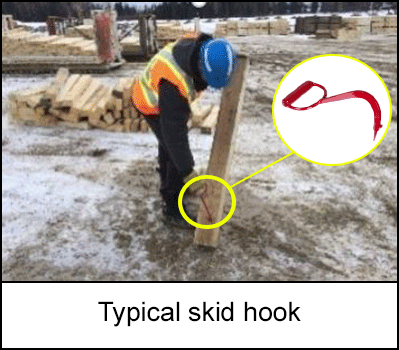-
What happened?
A worker using a skid hook to grasp timbers was injured when the skid hook struck the
worker’s knee.The worker was stacking timbers under pipe sections for further work.
The timbers were frozen and covered with ice and snow which caused the hook to slip
and contacting the workers knee resulting in a puncture wound that later became
infected.
-
Why did it happen?
- Timbers were frozen and ice-covered.
- Improper body positioning, in the line of fire.
Contributing factors:
- The hazard analysis did not take environmental changes into account.

-
What did they learn?
The company:
- Need to re-issue and review the safe work practice (SWP) for skid hook handling
with all affected crews. - Conduct focused inspections on skid hook use as laid out in the SWP.
- Develop and implement a competency evaluation for skid hook use.
General considerations:
- Determine proximity to other workers when working with skid hooks.
- Ensure workers are familiar with and competent in the use of skid hooks.
- Workers body position not in the line of fire.
- Conduct hazard assessments prior to all tasks.

- Need to re-issue and review the safe work practice (SWP) for skid hook handling
-
Ask yourself or your crew
- How can something like this happen here (e.g. on our site)?
- What safety measures (i.e. procedures, controls/barriers) do we have in place to mitigate the risk?
- How do we know the risk controls/barriers are working?
- What improvements or changes should we make to the procedures, controls/barriers or the way we work?

Add to homescreen
If you want to add this app to home screen tap and then ‘Add to Home Screen’.
Content name
Select existing category:
Content name
New collection
Edit collection
What happened?
A worker using a skid hook to grasp timbers was injured when the skid hook struck the
worker’s knee.
The worker was stacking timbers under pipe sections for further work.
The timbers were frozen and covered with ice and snow which caused the hook to slip
and contacting the workers knee resulting in a puncture wound that later became
infected.

Why did it happen?
- Timbers were frozen and ice-covered.
- Improper body positioning, in the line of fire.
Contributing factors:
- The hazard analysis did not take environmental changes into account.
What did they learn?
The company:
- Need to re-issue and review the safe work practice (SWP) for skid hook handling
with all affected crews. - Conduct focused inspections on skid hook use as laid out in the SWP.
- Develop and implement a competency evaluation for skid hook use.
General considerations:
- Determine proximity to other workers when working with skid hooks.
- Ensure workers are familiar with and competent in the use of skid hooks.
- Workers body position not in the line of fire.
- Conduct hazard assessments prior to all tasks.
Ask yourself or your crew
- How can something like this happen here (e.g. on our site)?
- What safety measures (i.e. procedures, controls/barriers) do we have in place to mitigate the risk?
- How do we know the risk controls/barriers are working?
- What improvements or changes should we make to the procedures, controls/barriers or the way we work?
Published on 22/06/23
1506 Views
A worker using a skid hook to grasp timbers was injured when the skid hook struck their knee while stacking frozen and icy timbers under pipe sections, resulting in a puncture wound that later became infected.
Original material courtesy of Energy Safety Canada














